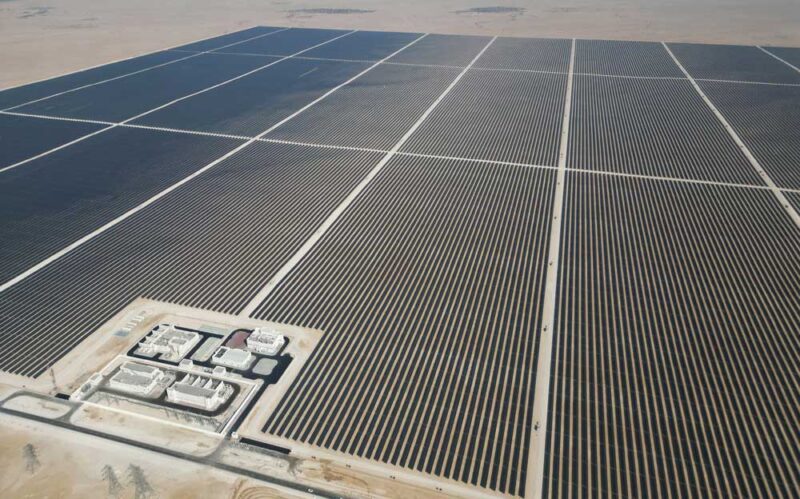Since Qatar was appointed as the host of the 2022 FIFA World Cup by (FiFA) in 2010, this country on the Arabian Peninsula has budgeted a fantastic amount of funds. reported by Reuters.com, to hold the most prestigious four-year football event which takes place from November 20 to December 18, 2022, Qatar is reported to have spent at least $229 million for the construction of infrastructure for the 2022 World Cup. These fantastic funds were not only used for the construction of 8 magnificent stadiums and a new city called Lusail, but Qatar is also building various supporting facilities, one of which is the construction of a solar power plant on an area of 1000 hectares or about 10 km2 called Al Kharsaah solar power plant. The solar-powered power plant is built in a desert area which is only 80 km west of Doha City, the capital of Qatar. The Al Kharsaah power plant is Qatar’s first non-fossil fuel power plant, built independently by Power-China Guizhou Engineering Co. Al Kharsaah Solar Photovoltaics (PV) Independent Power Producer (IPP) is also the first large-scale solar power project to be built in Qatar, this solar power plant is claimed to be able to generate electricity of 800 MW. This project is owned and operated by Siraj 1 SPV; a consortium jointly owned by TotalEnergies & Marubeni (40%) and Siraj Energy (60%); which is a joint venture between QatarEnergy (Qatar Petroleum) and Qatar Electricity & Air Co (QEWC).
The construction project of the Al Kharsaah solar power plant started in July 2020 and started operations in mid-October 2022. Significantly, Al Kharsaah is increasing the use of renewable energy in the energy consumption mix of football events and helping Qatar’s commitment to hosting a carbon-neutral World Cup. According to Wei Yujin (deputy project manager of Al Kharsaah solar power plant) reported by DailyChina.Com, “The carbon savings from this project will be used to offset about half of the emissions generated during the World Cup and are expected to provide around 1.8 billion kilowatt-hours. clean electricity to Qatar every year, which can meet the electricity demand of 300,000 families in Qatar.” So, it can also be said that this Show has contributed to providing a legacy of environmentally friendly energy for Qatar for the future.
Reporting from the official FIFA World Cup 2022 Qatar page, the Supreme Committee for Delivery & Legacy (SC) has announced that the carbon savings from Qatar’s new 800 MW solar power plant will also be used to offset around half of the emissions. generated by the host country of that FIFA™ World Cup. The Al Kharsaah solar power plant project is expected to save 1.8 million tons of carbon for Qatar in 2022. The project, which covers 10 km2 or the equivalent of 1,400 football fields, is also expected to help reduce the amount of carbon in Qatar significantly.
In a report published by FIFA in 2021, it is estimated that the FIFA World Cup 2022 Qatar will produce around 3.6 million tons of carbon emissions. The data is planned to be collected during the tournament to update the carbon inventory report and adjust the offset strategy accordingly. While about 50% of emissions will be offset by savings from solar power generation, SC will secure an additional 1.5 million tons through a carbon offset project approved by the Global Carbon Council.
SC in collaboration with FIFA has prioritized climate action for the last 12 years, as detailed in the FIFA World Cup Qatar 2022™ Sustainability Strategy. Tournament organizers have committed to making the World Cup carbon neutral through a range of comprehensive initiatives, such as free public transport for fans and officials, no domestic flights, green building practices, extensive recycling and composting, and electric vehicles. FIFA World Cup Qatar 2022™ carbon neutral is Qatar’s national effort to increase the use of renewable energy in the energy consumption mix of football events and helps Qatar’s commitment to be the best World Cup host.
by: Amir Fuad Asy’ari
Source:
- A. Mills, “Analysis: Qatar scores as World Cup host but may not net long-term goals,” reuters.com, 2022. https://www.reuters.com/lifestyle/sports/qatar-scores-world-cup-host-may-not-net-long-term-goals-2022-05-05/ (Accessed 29 Nov. 2022).
- P. Pouyanné, “Al Kharsaah, a pioneering solar power plant in Qatar”, TotalEnergies.com, 2022. https://totalenergies.com/projects/renewables-electricity/al-kharsaah-pioneering-solar-power-plant-qatar (Accessed 29 Nov. 2022).
- Y. Jun dan Z. Huiying, “Chinese-built solar project makes World Cup greener,” chinadaily.com.cn, 2022. https://www.chinadaily.com.cn/a/202211/28/WS6383ecc9a31057c47eba14a2.html (Accessed 29 Nov. 2022)
- Supreme Committee for Delivery & Legacy, “Qatar’s new solar power plant to help the country deliver a carbon-neutral FIFA World Cup™,” Supreme Committee for Delivery & Legacy, Qatar 2022. https://www.qatar2022.qa/en/news/qatars-new-solar-power-plant-to-help-the-country-deliver-a-carbon-neutral-fifa-world-cup (Accessed 29 Nov. 2022).
- FIFA, “FIFA Qatar 2022™ Greenhouse gas accounting report,” qatar2022.qa. 2022. https://www.qatar2022.qa/sites/default/files/2022-08/greenhouse-gas-accounting-report-en.pdf#page=23 (Accessed 29 Nov. 2022).
- Image source: https://s.thepeninsula.qa/nbhjis (Accessed 7 Jan. 2022).

